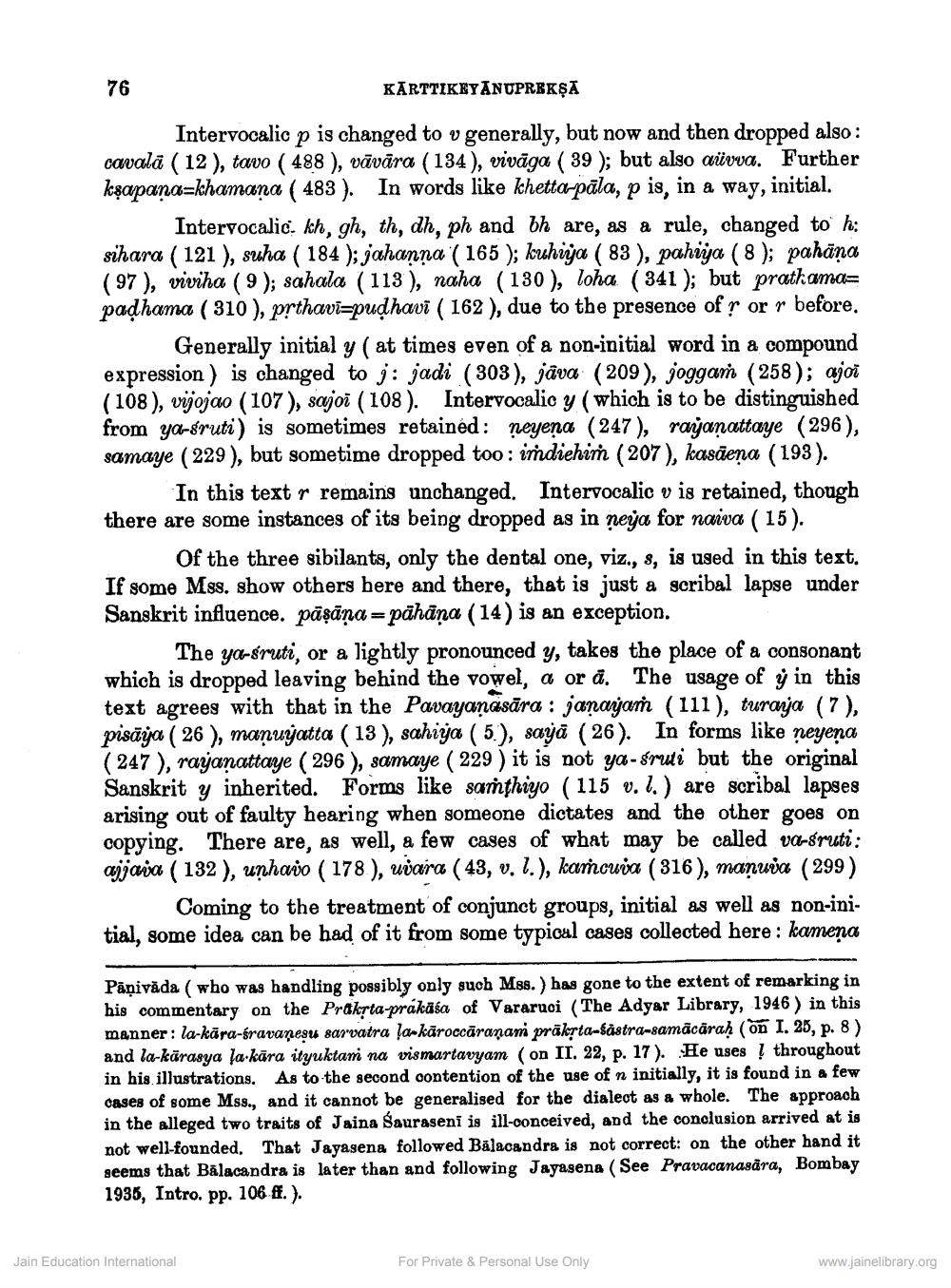________________
76
KĀRTTIKEYANUPREKŞA
Intervocalic p is changed to v generally, but now and then dropped also: cavalā (12), tavo ( 488 ), vāvāra (134), vivāga ( 39 ); but also aüvva. Further ksapana-khamana ( 483 ). In words like khetta-pāla, p is, in a way, initial.
Intervocalic. kh, gh, th, dh, ph and bh are, as a rule, changed to h: sihara ( 121 ), suha ( 184 ); jahanna ( 165 ); kuhija ( 83 ), pahija ( 8 ); pahāņa (97), viviha ( 9 ); sahala (113), naha (130), loha ( 341 ); but pratkama= padhama ( 310 ), prthavirpudhavi ( 162 ), due to the presence of or r before.
Generally initial y ( at times even of a non-initial word in a compound expression ) is changed to j: jadi (303), jāva (209), joggar (258); ajoi (108), vijojao (107), sajoi (108). Intervocalicy (which is to be distinguished from ya-sruti) is sometimes retained: neyena (247), rajanattaye (296), samaye (229), but sometime dropped too: imdiehiṁ (207), kasāena (193).
In this text r remains unchanged. Intervocalic v is retained, though there are some instances of its being dropped as in neya for naiva ( 15).
Of the three sibilants, only the dental one, viz., s, is used in this text. If some Mss. show others here and there, that is just a scribal lapse under Sanskrit influence. pāşāņa = pāhāna (14) is an exception.
The ya-sruti, or a lightly pronounced y, takes the place of a consonant which is dropped leaving behind the vowel, a or å. The usage of ġ in this text agrees with that in the Pavayanasāra : janayam (111), turaja (7), pisāja ( 26 ), manuyatta (13), sahiya (5.), sayā (26). In forms like neyena ( 247 ), rayanattaye ( 296 ), samaye ( 229 ) it is not ya-sruti but the original Sanskrit y inherited. Forms like samthiyo ( 115 v.l.) are scribal lapses arising out of faulty hearing when someone dictates and the other goes on copying. There are, as well, a few cases of what may be called va-sruti: ajjaja ( 132 ), unhaio ( 178 ), uvara ( 43, v. l.), kacuia (316), manuva (299)
Coming to the treatment of conjunct groups, initial as well as non-initial, some idea can be had of it from some typical cases collected here: kamena
Pāṇivăda ( who was handling possibly only such M88.) has gone to the extent of remarking in his commentary on the Prakrta-prákāśa of Vararuoi (The Adyar Library, 1946) in this manner: la-kära-gravanesu sarvatra la-kāroccāraṇam präkrta-fästra-samācārah (on I. 25, p. 8) and la-kärasya la.kāra ityuktari na vismartavyam (on II. 22, p. 17). He uses ļ throughout in his illustrations. As to the second contention of the use of n initially, it is found in a few cases of some Mss., and it cannot be generalised for the dialect as & whole. The approach in the alleged two traits of Jaina Sauraseni is ill-conceived, and the conclusion arrived at is not well-founded. That Jayasena followed Balacandra is not correct: on the other hand it seems that Balacandra is later than and following Jayasena (See Pravacanasära, Bombay 1935, Intro. pp. 106 ff.).
Jain Education International
For Private & Personal Use Only
www.jainelibrary.org




